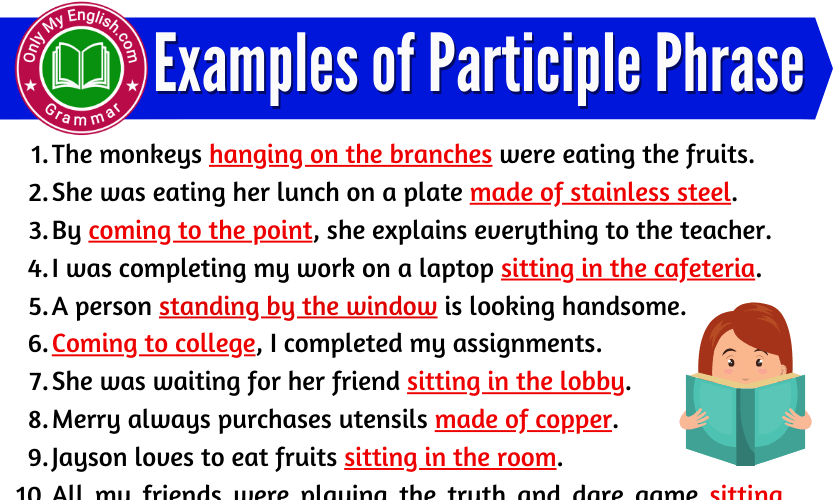Understanding The Essence Of A Participle Phrase
When diving into the world of grammar, one encounters various terms that may seem daunting at first. Among these, the concept of a participle phrase stands out as a significant element in crafting effective sentences. A participle phrase functions as an adjective, providing additional information about a noun or pronoun, and it can greatly enhance the clarity and richness of your writing. By mastering this grammatical tool, you can elevate your communication skills and convey your thoughts more effectively.
Participle phrases are formed using participles, which are verb forms that end in -ing (present participle) or -ed (past participle). They work in conjunction with other words to create a phrase that describes a noun or pronoun within a sentence. Understanding how to utilize participle phrases allows writers to add layers of detail and context, making their writing more engaging and informative. Whether you are a student, a professional writer, or simply someone who enjoys crafting sentences, grasping the concept of a participle phrase is essential.
In this article, we will explore what a participle phrase is, its structure, and how it can be effectively used in sentences. We will answer common questions related to participle phrases and provide examples to illustrate their practical application. By the end of this guide, you will have a comprehensive understanding of participle phrases and be able to implement them skillfully in your writing.
What is a Participle Phrase?
A participle phrase is a group of words that includes a participle and any modifiers or complements that accompany it. Together, these words act as an adjective, providing additional information about a noun or pronoun in a sentence. For example, in the sentence "The dog, barking loudly, chased the mailman," the participle phrase "barking loudly" describes the noun "dog." This phrase enhances the reader's understanding of the dog's actions.
How is a Participle Phrase Formed?
To form a participle phrase, one must start with a participle (either present or past) and then add any modifiers or objects associated with it. The structure typically looks like this:
- Participle + Modifiers + Objects
For instance, in the phrase "Running swiftly through the park," "Running" is the present participle, and "swiftly through the park" serves as the modifier and complement, giving more detail about the action. Understanding this structure is crucial for correctly forming participle phrases in your writing.
Can Participle Phrases Be Misused?
Yes, participle phrases can be misused if not placed correctly in a sentence. Misplaced participle phrases can lead to confusion or unintended meanings. For example, in the sentence "Running down the street, the dog chased the cat," it seems to imply that the dog is the one running, rather than a person. To avoid such confusion, always ensure that the participle phrase is placed close to the noun it modifies.
What are the Functions of Participle Phrases?
Participle phrases serve several important functions in writing:
- Describing actions or states of being
- Providing additional context to the main action
- Creating complex sentences that convey more information
- Enhancing the overall flow and style of writing
By effectively using participle phrases, writers can create a more vivid and engaging narrative, allowing readers to visualize actions and emotions more clearly.
Are There Different Types of Participle Phrases?
Yes, there are two primary types of participle phrases based on the form of the participle used:
- Present Participle Phrases: These phrases use the -ing form of a verb. For example, "Laughing at the joke, she felt a sense of joy."
- Past Participle Phrases: These phrases use the -ed form of a verb (or irregular forms). For instance, "Excited by the news, he hurried to share it with his friends."
Each type serves to enhance the sentence's descriptive quality, allowing for more nuanced expression in writing.
How Can I Identify Participle Phrases in a Sentence?
Identifying participle phrases can be done by looking for the following elements:
- Presence of a participle (either -ing or -ed)
- Modifiers that provide additional detail
- Position in the sentence, typically near the noun it describes
For example, in the sentence "Exhausted from the long day, she collapsed onto the couch," "Exhausted from the long day" is the participle phrase describing "she." Recognizing these patterns will help you better understand and utilize participle phrases in your writing.
What are Some Common Mistakes with Participle Phrases?
Writers often make a few common mistakes when using participle phrases:
- Misplaced Modifiers: As mentioned earlier, placing a participle phrase too far from the noun it modifies can lead to confusion.
- Dangling Participles: This occurs when the participle phrase does not clearly relate to a noun in the sentence, leading to ambiguity. For example, "After reading the book, the movie was disappointing" implies the movie read the book.
- Overusing Participle Phrases: While they can enhance writing, overuse can make sentences convoluted and difficult to read.
By being aware of these mistakes, writers can improve sentence clarity and effectiveness.
Can Participle Phrases Be Used in Different Writing Styles?
Absolutely! Participle phrases can be employed in various writing styles, from formal academic papers to creative storytelling. Their versatility allows writers to adjust their tone and style according to the context of their writing. Whether you are crafting an essay, a report, or a fictional narrative, participle phrases can enhance your writing and engage your audience.
Conclusion: Mastering the Use of Participle Phrases
In conclusion, understanding what a participle phrase is and how to use it effectively can significantly improve your writing skills. By mastering the structure, functions, and common pitfalls associated with participle phrases, you can create more dynamic and engaging sentences. Remember to practice identifying and using these phrases in your writing, and you'll soon find that they become an invaluable tool in your grammatical arsenal.
Exploring The World Of Movierulz Adult: A Comprehensive Guide
Unveiling The Complexity Of Erin Moriarty's Relationships
Rob Lowe's Iconic Role In The Outsiders



ncG1vNJzZmiqn5i4o77InZ6emqKqtq%2B%2FjaipoGeYmq6twMecmKudkZiwpr%2FSpaCmoaSasXDDx5qrZqGjYq5uvMCrq6KbmaW5pnnPoamaq5VjtbW5yw%3D%3D
